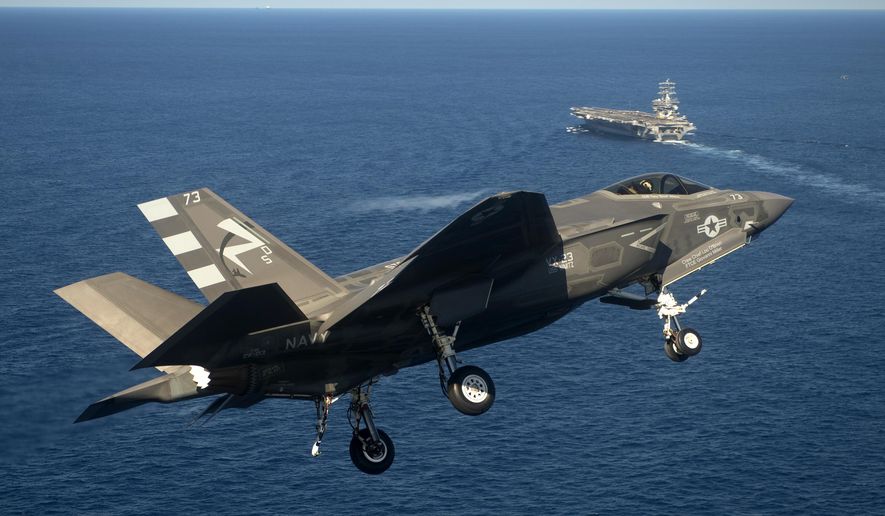American air power is declining at the very moment U.S. warplanes have been thrust into a long war in the skies over Iraq and Syria and must contain aggressive militaries in Russia and the Pacific.
Now Congress, which has watched combat readiness decline under the crunch of automatic budget cuts called “sequestration” in 2013, is intervening. Congress is restocking the Air Force and Navy with more missiles and planes than requested in President Obama’s defense budget.
The backdrop: The Air Force continues to shed jet fighters, and, more troubling, oversees 54 fighter squadrons for which less than half are fully combat-ready, says a new report from the Senate Armed Services Committee. To meet lower budgets, the Air Force plans to reduce the squadron count even further — to 49 — by eliminating the venerable A-10 “Warthog.”
Regarding naval air forces, the Navy does not own sufficient numbers of F/A-18 Hornets, its frontline, all-purpose attack jet, and is short one of its main weapons: radar-guided anti-aircraft rockets. The sea service is in danger of running out of its most lethal ship-launched weapon — the Tomahawk — before a new cruise missile is put into production.
“This is the worst operational readiness that the Air Force and Navy have ever seen in our history,” said retired Air Force Lt. Gen. Thomas McInerney, a fighter pilot in Vietnam.
The troubling picture has arisen in recent months in congressional testimony, public statements and the Senate committee report on fiscal 2016 Pentagon spending.
PHOTOS: Top 10 U.S. fighter jets
The committee warned of increased risks in the air war against the Islamic State terror army in Iraq and Syria. Led by Sen. John McCain, Arizona Republican, the panel is trying to rebuild air power assets and reverse the slide by moving money around in the $612 billion budget.
Said the report: “The committee believes further reductions in fighter force capacity, in light of ongoing and anticipated operations in Iraq and Syria against the Islamic State of Iraq and the Levant, coupled with a potential delay of force withdrawals from Afghanistan, poses excessive risk to the Air Force’s ability to execute the National Defense Strategy.”
The committee is recommending a number of fixes.
It responded to persistent complaints from military officials that the Air Force does not fly a sufficient number of remotely piloted aircraft (RPA). The committee increased spending on the MQ-9 Reaper to over $1 billion for two dozen strike drones on top of the 29 requested.
Senators also voted to increase the buy of Tomahawks, which are launched from surface ships and submarines, from 100 to a minimum of 196 next year. They also ordered the Navy to keep the production line open, noting the Navy has unleashed the cruise missile over 2,000 times the past two decades and fired it into Syria in the ongoing war against the Islamic State.
“The Navy recognizes that the existence of a production gap between the end of new missile builds and the start of recertification will put tremendous strain on the Tomahawk supplier,” it says. “The committee believes that it would be imprudent to ramp down and close production.”
The Navy also is not buying enough F-18 Hornets, the backbone of its carrier-launched air force.
It requested no new F-18s in 2016. The committed added $1.2 billion to buy 12.
“Procuring additional F/A-18E/F aircraft will reduce near-term strike fighter inventory gaps and risk,” it says. It also added money to buy more air-to-air missiles after Adm. Jonathan Greenert, the chief of naval operations, acknowledged a shortfall.
With 49 planned Air Force squadrons, the service would be hard-pressed to conduct a major air war, such as the 1991 Desert Storm over Iraq. That aerial bombardment required 33 fighter squadrons while keeping 14 set aside to protect the homeland. The math: If a new Desert Storm is ordered, there would only be two squadrons remaining to cover the rest of the world.
The Senate mitigated that gap somewhat by preventing the Air Force from deactivating five A-10 squadrons in 2016 on the argument that no dedicated close air support replacement exists.
“In every capability area, and not just fighter squadrons, we’re cutting every one of our five core mission areas in this budget, as we did last year and the year before,” Gen. Mark Welsh, Air Force chief of staff, told the committee earlier this year. “The trend is all in the wrong direction in every mission area, and we don’t see it stopping. That’s the danger side.”
Air Force Magazine, published by the nonprofit Air Force Association, issued a blistering editorial on the deteriorating state of the 310,000-airman service.
“The Air Force is still at war now for 24 straight years. All the while, the force has gotten smaller, the inventory older still, and budgets are down significantly from eight years ago. What has not decreased is demand for Air Force airpower,” wrote Adam J. Hebert, editor in chief. “There is a fundamental disconnect between the service’s missions and the resources USAF is provided to perform those missions.”
• Rowan Scarborough can be reached at rscarborough@washingtontimes.com.




Please read our comment policy before commenting.